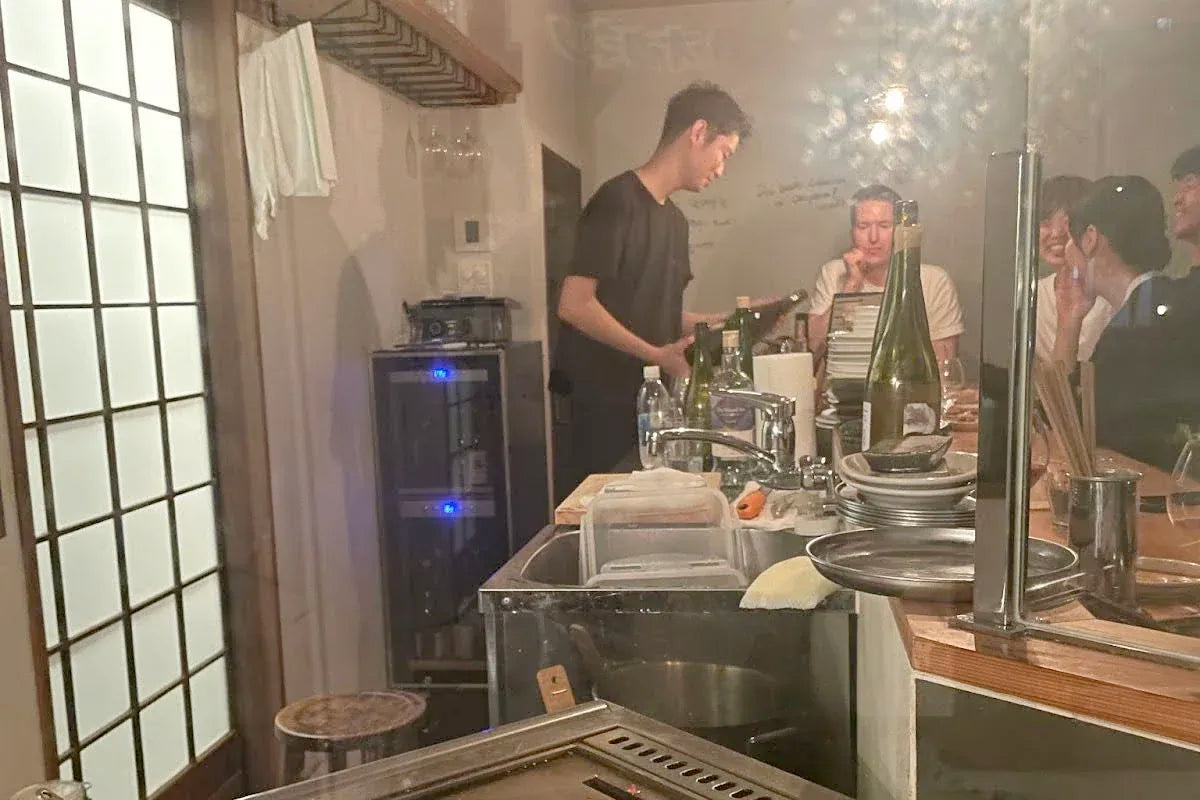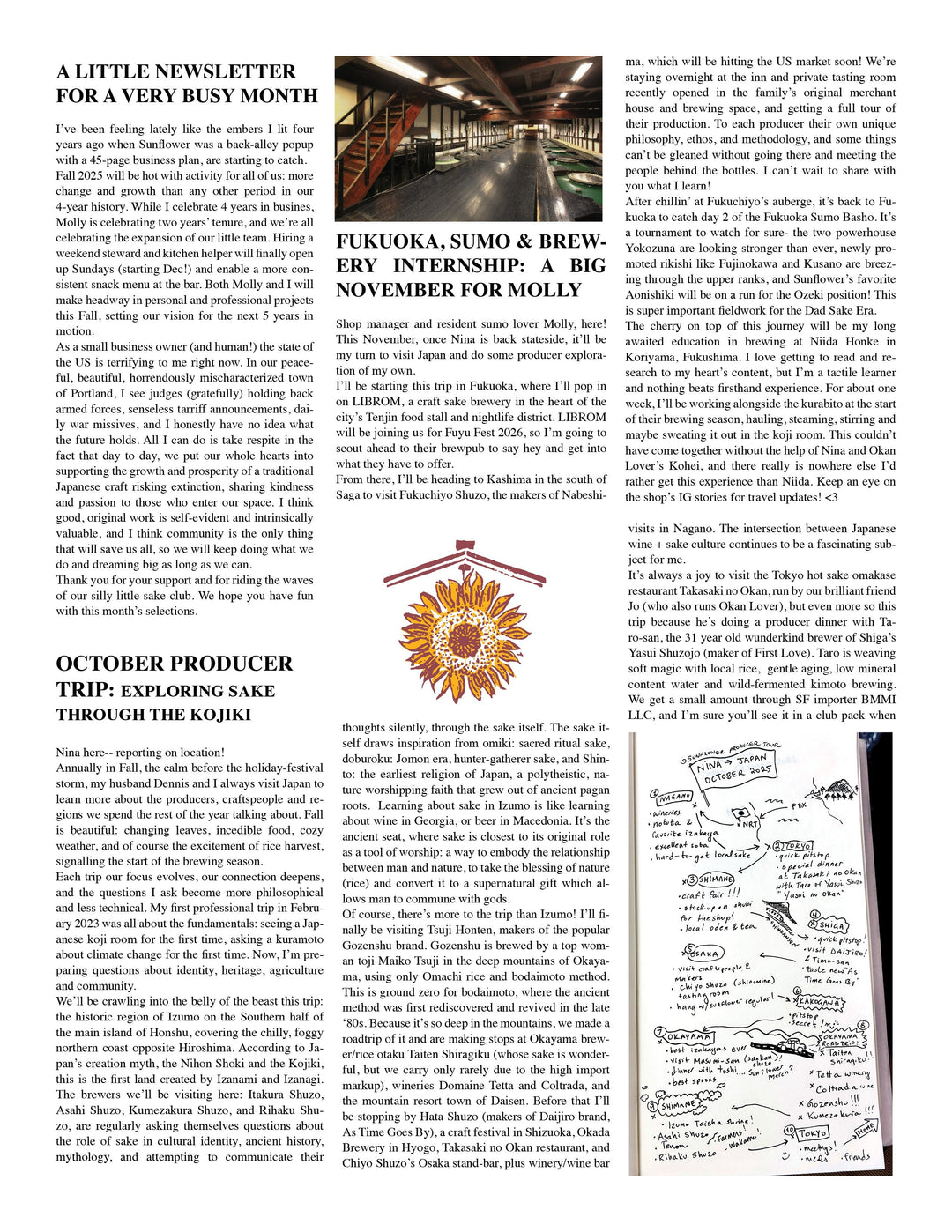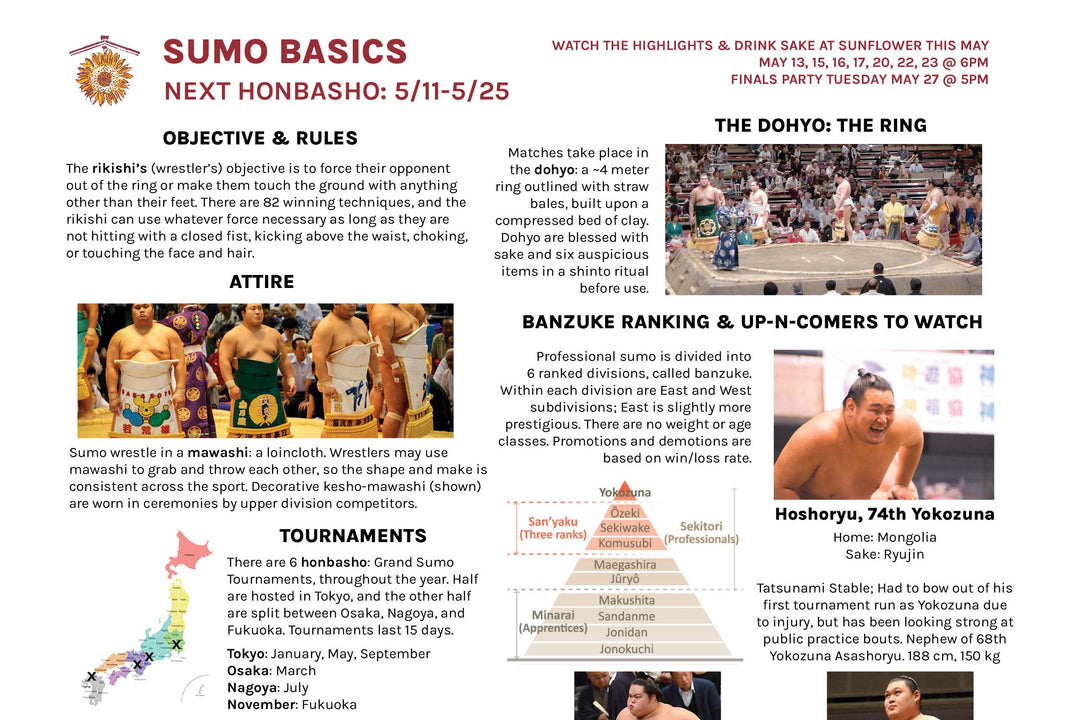JUNE 24, Treasures from Okayama, Part 1: Chikurin Otoro Namazake + the protein contradiction

Dinner & impromptu kanzake with new friends at Love Song, a natural wine, raw fish & okonomiyaki bar, Okayama City
Sunflower Sake Club, June 2024: Okayama
This month’s theme, loosely, is Okayama– treasures from Okayama, I suppose– featuring two very different but highly representative sake. The connection between farmer and sake in Okayama feels a lot closer than Niigata, Akita, Ishikawa…many other places I’ve visited. These two breweries are good examples of that in different ways.
If you find yourself in Japan, particularly thinking about Osaka, Hiroshima or Kyoto, consider spending a few days in Okayama, which is only an hour from Osaka by Shinkansen. I was thoroughly charmed by the city, and by Kurashiki, where we stayed for 4 nights. Our day trip to thelittle coastal town of Kojima, famous for Japanese denim manufacturing (this area has a long history of growing cotton, as the soil is too salty for rice) left me wishing we spent more time there. Origin Sake founder and Hyogo tour guide (highly recommended!!) Andrew Russell seemed to be friends with everyone in Kurashiki/ Kojima as it is his own stomping grounds, and he first worked at a brewery right next door to my husband’s favorite denim atelier, Cottle. Somehow, this place I’d never been to before, felt familiar.
Okayama City reminded me a bit of Portland. It’s smallish, neighborhoody, cute, on the edge of sooo much farming land, and even mountains. It has a long history of industry and manufacturing– mostly petrochemicals and cars. The people are proud of their agricultural roots and blue collar foundation. There aren’t many tourists here, so it feels completely different– the peaceful and neighborhoody Japan you might imagine in your mind, rather than the traffic jam of Kyoto. What also appealed to me was the intimate relationship between consumer and producer. In small wine bars and sake bars, proprietors knew the makers personally. The person making wine is their friend, their neighbor: they respond to Instagram calls to action, for help needed at bottling time, or harvest time. These people are sharing products originating within their own communities. They aren’t cool products in the abstract, they are their friends’ products and their own personal stories. That’s how I feel about Oregon wine these days and I know what kind of a difference it makes in how we pair, share, and feel.
Don’t you want to taste something delicious made by a friend?

Marumoto Shuzo, Chikurin Junmai Ginjo Nama “Otoro”
Everything about Marumoto Shuzo suggests that I should lead with a picture of rice farming. And to a degree I’ve yet to encounter elsewhere– despite specifically seeking out breweries that raise their own rice– Marumoto Shuzo farms with incredible specificity, a vision of the final product and even role of the rice affecting every decision. The brewery currently farms over 50 hectares (~125 acres) in 150 separate parcels, and sources the balance of their rice needs in close collaboration with local farmer-brewers. In this respect it could be called a cooperative brewery, not unlike the highly regarded La Chablisienne wine cooperative in Burgundy, France.
But of course, this wasn’t always the case. Until the 1980s, and in practical terms until the late 2010s, estate rice farming was virtually unheard of. All rice was collected, graded and redistributed by the JA, a government entity that had managed rice supply since pre-WW2. If you owned a brewery and your neighbor grew rice, you couldn’t just buy it from him; he was legally obligated to sell the rice to the JA, and you were legally obligated to purchase virtually anonymous sources from the JA yourself. In order to ensure consistent supply and price, the connection between brewer and farmer was lost.
In 1986 the 6th generation president looked at the brewery balance sheets and had an uncomfortable realization. “I looked at the financial statements and saw that more than half of the cost of sake was for rice. At that time, all rice distribution and prices were under government control, and the purchasing conditions were the same for both large and small sake breweries. [I] felt anxious about the future of being complacent with this. So [I] started to work on growing [my] own rice.” Starting with the family plots (~6 acres), he proceeded through ridicule and criticism from neighbors. “For the first 25 years or so, I was mostly told, "You're just being self-satisfied," or "Because it's cheaper?" The people around me looked at me with a very cold attitude, and I felt lonely.” But once he had acquired ~55 acres and the associated experience, his connection to the process deepened. “When I got to this point, I went into the fields, felt the soil, and thought things like, "This area is good for koji rice, and that field is good for kakemai" and the relationship between rice cultivation and sake brewing began to emerge.”
The Protein Contradiction
When farmers grow rice and sell it to the JA (which is still, by far, the primary way breweries source their rice) they’re interested in receiving the highest revenue per tan (~.25 acre). This is dependent on two factors: yield (which can mean more grains + bigger individual grains), as well as the highest grade for the rice, which is based on a visual inspection. Factors assessed include size, the number of grains with a visible shinpaku (starchy center), the number of cracked grains, undeveloped green grains, foreign grain and foreign matter, and more. Ignoring regional quality designations (applicable only in Hyogo), there are 6 grades of sake rice, one being ungraded.

(As usual, Tim Sullivan to the rescue with the rice classification chart)
Unrelated but interesting, eating rice is subject to 3 official grades but many, many unofficial subjective evaluations and categories, from a wide range of industry stakeholders. Rice Meisters (Rm)-- of which there are a few thousand-– are the Masters of Wine of the rice industry, and perform the noble task of tasting and evaluating rice for consumers and issuing detailed descriptions of texture, flavor, and recommended use (see below).

It goes without saying, but Japan is very serious about rice.
The farmer’s desire for maximum yield and maximum grade seems like it could serve everyone’s interests. But unfortunately, the way to achieve this undermines the quality of rice for the purpose of ginjo-style sake brewing, which is how most premium sake is made today. To achieve high yields and large grain size, rice– a very nutrient-greedy crop– is fertilized heavily with nitrogen-rich fertilizers. Competing plants (weeds) are managed meticulously with herbicides and pests with chemical pesticides. The absence of weed competition lets each seedling produce more grains, while nitrogen in the fertilizer converts to amino acids in the developing grain (Effects of Nitrogen Fertilizer on the Starch Structure, Protein Distribution, and Quality of Rice, ACS Food Science and Technology, 7/2022) increasing its size and protein content.
The rice is harvested, graded, and if it’s sufficiently large, ripe, and unbroken, given top grade: tokujo. The sake brewer pays handsomely for the tokujo rice, then promptly mills away the outer 30-50% specifically to reduce its protein content! This is the protein contradiction.
And this is the reason why, in many cases, the interests of the brewer and farmer are misaligned. I’m sure you can then imagine the scale of the issue when the brewer and farmer are completely disconnected, as in the JA rice distribution system. Among other reasons, this is why we’re seeing brewers get more involved in their rice sourcing, whether by contracting directly with local growers or by growing the rice themselves.
![]()
San-yo Zukuri
The title below the first image, shown again here, refers to “san-yo zukuri,” a unique method of cultivating sake rice that starves the plant of nutrients three times in the growing season. Professor Masaharu Nagatani, who worked for Japan’s National Tax Agency and was a leading researcher in Yamadanishiki cultivation, helped Marumoto Shuzo develop this method.
“First, the seedlings are starved before transplanting. This causes their green color to fade slightly. The purpose is to make the seedlings malnourished so that they take root immediately after planting.
The second time, the developed plants are starved at the beginning of August during the young panicle formation period. This also causes the green color to fade slightly. At this time it’s necessary to switch nutrients from rice growth to ear development. Excessive nitrogen will delay the internal switch, so nitrogen content in the fertilizer is reduced.
The third time, the color of the rice at the time of harvesting is assessed. If the rice has too deep a shade of green it suggests that the plant is carrying a lot of nitrogen, which means that protein will accumulate in the rice.” (kamomidori.co.jp/rice_farming)
There are, of course, organic rice farmer-brewers (for example Akishika) who take a much more hands-off approach, utilizing no mid-season fertilizers, organic or otherwise. But to me, Marumoto’s approach is reflective of their research and data-driven style of farming. Marumoto wants to make an aromatic, juicy style (like Otoro!) rather than an earthy, ricey style (like Akishika, Tsukinoi, or Izumibashi). This takes a greater commitment to nutrient optimization, particularly in an organic field.
Finally, they take their farming specificity a step further by cultivating rice according to its final use.
We utilize "purpose-specific cultivation": rice for koji, versus rice used for the main mash. Each field has its own characteristics, so we first check its suitability, then select the field and design the fertilization to suit each purpose. To do this, we analyze the soil of all fields and improve the soil over a period of about three years. We then…carry out "selective harvesting" by processing each field of rice through drying, hulling, adjustment, and storage according to its purpose.”
Again, this is a level of specificity I personally haven’t yet encountered. Specific fields being used to create limited cuvees (as in Burgundy), sure, but not a 3-year process to nurture a field for koji making!
Chikurin Junmai Ginjo Namazake “Otoro”
Every year, Otoro is reliably a few things: full bodied, juicy, aromatic, a little rich and sweet. In this sense, it is dependably “southern” style ginjo (long-time members, contrast this with Senkin Yamadanishiki “Muku,” which feels like skim milk in comparison). But after about 4 years of tasting Otoro consistently, the thing that seems to vary from year to year is the impression of alcohol and how “over the top” those aromatics are. Put differently, the balance.
2021: “ Orange flower water, tangerine zest, violet candies, and a sweet tropical note-- lychee, rambutan. Delicately balanced, just-so sweetness.”
2022: “overt florals-- cherry blossom, rainier cherry, rose sugar. Alcohol is noticeably a little higher and there is a very slight bitterness/burn on the finish which provides a nice cleansing contrast to the sweetness.”
2023: “This year’s Chikurin is a fatter, broader, chewier expression. It has that Southern weight, but it is unmistakable and even excessive ethyl caproate [yeast aromas] the moment you smell it. Big strawberry, fake cherry fruit, mike and Ike-- Dennis found it downright offensive.” (I passed on it this year!)
2024: “That familiar chewy, juicy fruit on the nose, starburst, ripe Hood strawberry, tropical flowers, rainier cherry and pina colada. But there’s a really nice acidity, a structure on the mid palate that keeps me from feeling weighed down.”
Upon reflection, 2024 is my favorite of the four. It might be where I am right now in my personal tastes, it might be the residual magic of my visit to Okayama, it might be that I was able to enjoy (a different) seasonal Chikurin with a fellow Okayama kuramoto at an Izakaya. After all, there is no better seasoning than time, place, mood and company. But there’s something about this year’s Otoro that just hits the mark. It’s the right amount of fruity, floral, juicy, without being too heavy or tasting boozy. For the wine nerds, it reminds me of a small Bruno Clair Gevrey Chambertin vertical tasting I was privileged to be invited to two years ago. Each year you could describe the wine very similarly– the differences were subtle (I always remember the saying: the best wines in the world taste like raspberry and cherry, and the worst wines in the world taste like raspberry and cherry). But the pendulum swung from cherry-heads candy to tart black cherry so easily, and the alcohol swung from sweet and hot to light and filigreed on a dime, that I left really appreciating how much goes into achieving the “perfect balance” in a given year. So too with Otoro.
Pairing & Service
Chikurin starts sweet but finishes dry, and this year’s aromatics are generous but not too over the top. Serve from the fridge, but appreciate the changes that take place as it warms in your glass to room temperature. I tried this in a few different glasses and honestly had no favorite. The wine glass emphasized the acidity, which I appreciated when drinking it on its own; a guinomi minimized the aromas which I preferred with food. President/toji Niichiro Marumoto recommends pairing with dark and bittersweet chocolate truffles (a floral or fruity flavor would be great). I love Otoro with grilled steak, (or seafood or tofu!) & nahm jim jaew with a side of som tum (we make it with daikon when we can’t find green papaya) or summer salmon with fresh corn and tomato salsa. Being so similar to Fukucho’s Moon on the Water, oysters (dressed simply with lemon and hot sauce) are also a natural pair for its sweetness and weighty umami.
Stats
- Location: Okayama
- Brand: Chikurin (the brewery’s estate-grown line, named for the nearby Mt. Chikurin. They also make Joto Cup, not a Chikurin product, which is still primarily made from organic rice).
- Grade: Junmai Ginjo Nama Genshu
- Rice: Yamadanishiki (estate, organic)
- Polishing: 50% (so much for the protein contradiction, guys!)
- Yeast: #1801 (modern, ethyl caproate producing)
- Pressing: Yabuta (accordion press)
- ABV: 16%
- SMV: 0




